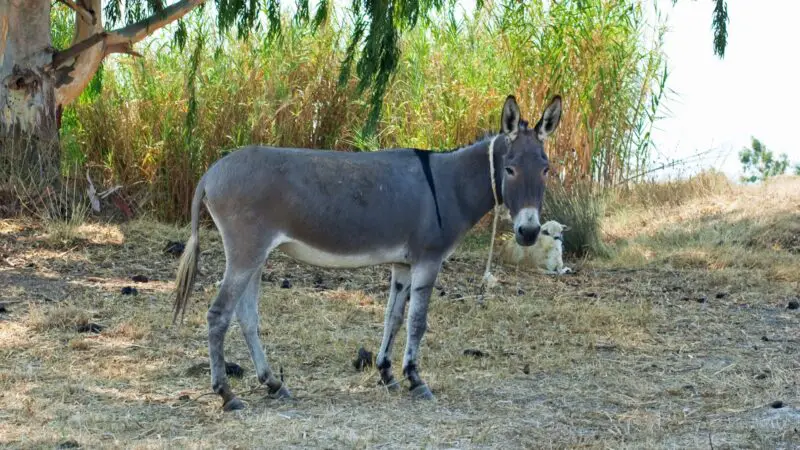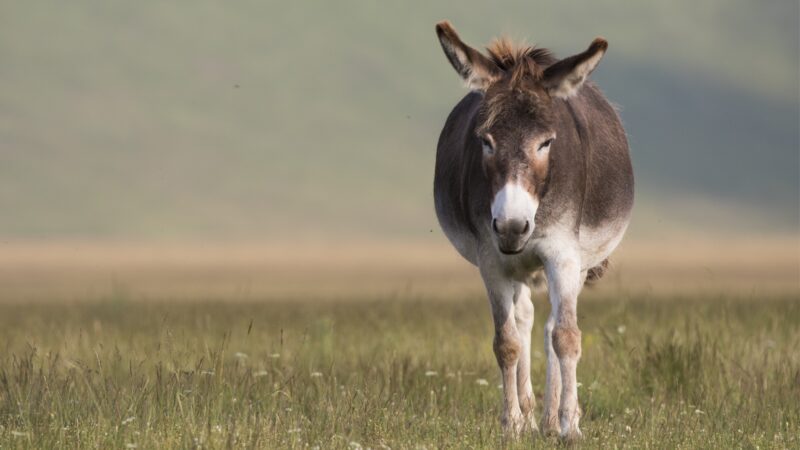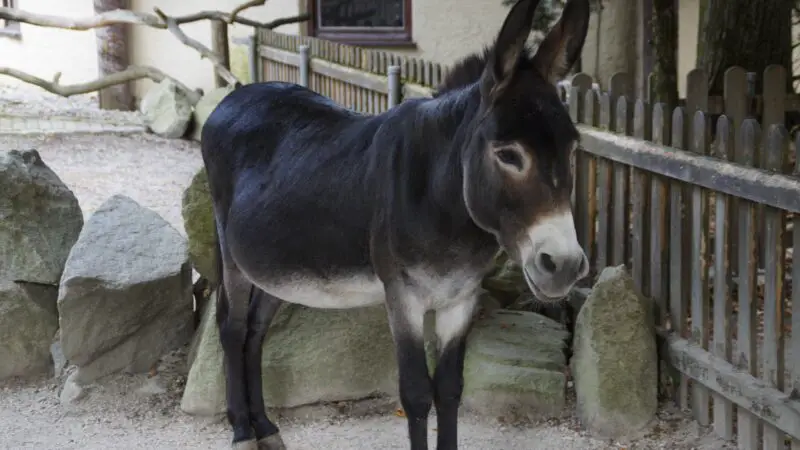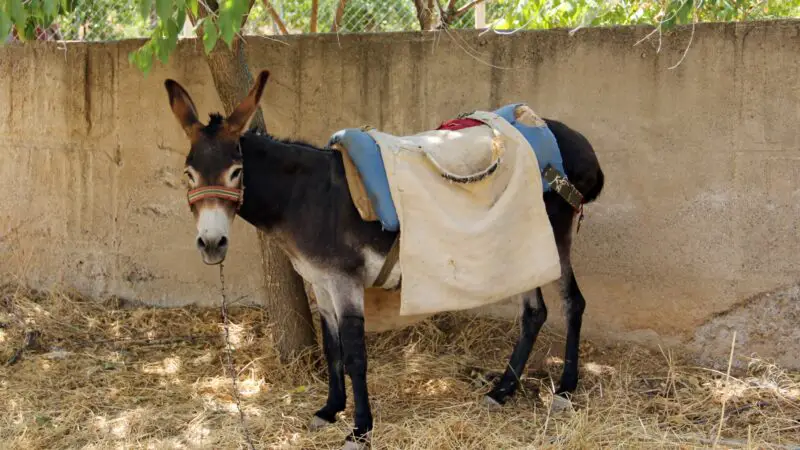If you are fond of donkeys, you may have already heard about the American Mammoth Jackstock. This heritage breed is very unique among all other donkeys.
If you are not familiar with donkeys, you might mistake these donkeys for small horses. To give an idea, American Mammoth Jackstock donkeys have a rich history and are gentle giants.
Scientifically known as Equus asinus americanus, the American Mammoth Jackstock is a breed of draft mule known for its powerful build, large size, and gentle disposition. American Mammoth donkeys are also smart and versatile animals. They can be used in riding, carrying, or pulling loads.
Contrary to what some people think, donkeys are not small horses. They are a separate species from horses and mules. Also called Mammoth donkeys, the American Mammoth Jackstock is a special breed of donkey.
If you are interested in raising them, this article will teach you everything about Mammoth donkeys and how to care for them.
American Mammoth Jackstock History

The history of American Mammoth Jackstock is not well documented, except that George Washington is credited as the first mule breeder. It happened during his presidency when the King of Spain gave him two Spanish Jacks, and one of them was named “Royal Gift.” At that time, there were no known large donkeys in the country.
Washington also received a Maltese jack from his friend and French aristocrat, Marquis de Lafayette. The American president bred “Royal Gift” with the Maltese jack, and the offspring was named Compound, which was later bred with horses. In 1788, he offered his jack for stud service, and the American Mammoth Jackstock was eventually created.
There were two different registries for the American Mammoth Jackstock – the first one was established in 1888, and the second one in 1908. To have a common standard, they merged in 1923 and named Standard Jack and Jennet Registry (SJJR). It is now called the American Mammoth Jackstock Registry. Then, the standards became stricter.
In 1920, the population of American Mammoth Jackstock donkeys was estimated to be five million. But because of the stricter height standards, the population dramatically reduced. It started to increase again in the 1950s when the SJJR decided to lower its standard. But in the 1980s, the SJJR returned to its original higher standard in height.
Where Do American Mammoth Jackstock Donkeys Originate?
As the name implies, the American Mammoth Jackstock originate in North America. Thanks to the huge contribution of one of the Founding Fathers, George Washington.
American breeders blended some strains of the Andalusian, the Baudet du Poitou, the Catalan, the Majorcan, and the Maltese in creating the American Mammoth Jackstock.
Are American Mammoth Jackstock Donkeys Rare?
The American Mammoth Jackstock is now considered rare. As of January 2023, the American Livestock Breeds Conservancy lists this donkey breed as “Critical.”
It means that the estimated global population is only less than 2,000, with less than 200 registrations annually in the US. Fortunately, their numbers are now slowly increasing.
American Mammoth Jackstock Identification

What Do American Mammoth Jackstock Donkeys Look Like?
American Mammoth Jackstocks come in black, brown, or gray, but black is the only one recognized. They have a large body, a wide forehead, large nostrils, long ears, and a deep chest.
Their ears measure about 33 inches (83.9 cm) from tip to tip. These large donkeys also have a thick, long mane and tail, well-muscled legs, and upright hooves.
How Big Do American Mammoth Jackstock Donkeys Grow?
Jacks (male American Mammoth Jackstock) stand at least 14.2 hands (58 inches) tall at the withers and How Much Does an American Mammoth Jackstock Costaround 61 inches (155 cm) around the heart girth.
On the other hand, jennets (females) are around 14.2 hands (56 inches) tall and have the same heart girth as males. When measuring the height of horses, a “hand” is equivalent to 4 inches.
Is the American Mammoth Jackstock a Heavy Breed?
American Mammoth Jackstock donkeys are a pretty heavy breed. They can weigh between 900 and 1,200 lbs (408 and 544 kilos). Romulos, which is the current tallest American Mammoth Jackstock in the world, weighs 1,300 lbs (589.7 kilos).
What Are the Distinct Characteristics of an American Mammoth Jackstock?
The American Mammoth Jackstock is the largest and heaviest donkey breed in the world. According to the Guinness World Records, a 9-year-old American Mammoth Jackstock named Romulus currently holds the record of the tallest donkey living in the world. Romulus stands 17 hands (172.72 cm; 5 ft 8 inches) tall, from hooves to withers.
What Do American Mammoth Jackstock Donkeys Eat?
American Mammoth Jackstock donkeys are herbivorous mammals, which means that they eat plants and plant material. Their digestive system is well-matched to a diet of roughage, including grass, hay, and straw.
However, feed them only with good clean grass hay. High-protein hays and alfalfa, which has 16-20% protein are bad for them.
American Mammoth Jackstock Temperament
American Mammoth Jackstock donkeys are known for their good temperament and gentle disposition. They are calm, docile, and generally easy to handle.
These working animals are also sociable, smart, and can handle difficult or stressful situations with a lot of patience. In general, all donkey breeds are more even-tempered than horses.
How Long Does an American Mammoth Jackstock Live?
Like other donkeys, the American Mammoth Jackstock can live between 30 and 50 years. Their actual lifespan depends on their genetics, living conditions, diet, and overall health.
What Is American Mammoth Jackstock Known For?
American Mammoth Jackstock donkeys are known for being very useful in a variety of tasks. This includes plowing fields, pulling carts and wagons, recreational riding, and means of transportation.
Aside from that, these working mammals are used in equine therapy, a horseback riding activity where a patient is being treated in connection with horses.
Are American Mammoth Jackstock Donkeys Good Pets?
American Mammoth Jackstock donkeys make good pets. They are very friendly, docile, intelligent, and easy to train.
Unlike horses, donkeys are generally less prone to behavioral problems such as bolting and spooking. They also thrive on human companionship and do well once they start to have a close bond with their owners.
How Much Does an American Mammoth Jackstock Cost?

The cost of an American Mammoth Jackstock depends on age, weight, height and overall health, as well as the skills that it can do.
A young, untrained American Mammoth Jackstock can cost a few hundred dollars, while an adult and well-trained one can cost several thousand dollars or more. Make sure to buy only from reputable breeders.
But to give you an idea about the actual price, an American mammoth donkey named Diamond Creek Moonwatcher was imported from Kentucky to Queensland, Australia in April 2021. The then 12-year-old American Mammoth Jackstock stands 15 hands (60 inches) tall. It was bought by breeder David Scholl for a whopping price of $60,000.
Is It Expensive to Raise American Mammoth Jackstock Donkeys?
It is expensive to raise an American Mammoth Jackstock. Aside from the hefty price of a foal (1-year-old baby donkey), you should also invest money for feed, veterinary care, farrier services (equine hoof care), equipment, and facilities. There are also additional costs if you plan to breed donkeys for show competitions or exhibits.
How Much Space Does a Mammoth Donkey Need?

Donkeys are recommended to have at least 50 sq ft (4.7 sq. m) of space for each head for indoor living space or shelter. But since American Mammoth Jackstocks are very large, you might want to have wider stables. Make sure that there is also enough space for people and donkeys to move around inside, as well as for feeders and waterers.
Stable doors should be at least 133 cm (4.3 feet) high, while the doorway is at least 1.2 m (3.9 ft) wide. Assume that more than one donkey can enter or exit at the same time. For pasture and exercise, a Mammoth donkey needs at least one acre (about 4.047 sq m) of space. The grazing area alone should be at least one-half acre per donkey.
Tips for Taking Care of American Mammoth Jackstock Donkeys
Raising American Mammoth Jackstock donkeys is not only expensive. It also requires close attention, patience, and time. Despite being large, Mammoth donkeys are still smaller than horses.
Note that donkeys are different from horses in terms of physical, mental, and emotional. Here are some tips on how to take care of American Mammoth Jackstock donkeys:
- American Mammoth Jackstock donkeys graze about 16 hours a day. They should eat dry matter 1.5% of their body weight a day.
- Overfeeding donkeys can lead to obesity and organ dysfunction, such as Equine hyperlipaemia and laminitis.
- Always provide donkeys with clean drinking water. Most of them prefer warm water instead of cold.
- During winter or colder months, place a small floating football on the water surface of the waterer to keep the water warm.
- Donkeys’ hooves are prone to health problems such as Abscesses and White line disease. Clean their feet regularly and trim them at least every 2 months.
- Feed Mammoth donkeys with a balanced diet that is high in fiber but low in protein.
- Donkeys, in general, are very social animals. It is not advisable to raise only one donkey or without an animal companion.
- Donkeys also develop very strong emotional attachments with each other and other animals. If a companion or a friend dies, allow them to stay with the dead body for at least an hour. In some cases, acceptance of the loss can take a whole night.
- Unlike horses, donkeys show limited response, which is why some owners think that they are stubborn. Teaching or training donkeys should not be rushed.
- Since some donkeys can learn to remove the top bolt on their stable doorways, add a bottom bolt. This will also help prevent their foot from getting caught in the door once they kick it.
- Donkeys are very susceptible to climatic conditions such as rain, snow, and wind. Always keep their living area dry and clean.
- During summer or hotter months, make sure that their stable has proper ventilation. You can also provide them with a small pool or hose them off.
- Provide donkeys with regular health care. They require deworming, regular vaccinations, and other necessary medical treatments.
- If you have several donkeys, provide them with multiple pastures so that the unused portion can regenerate while some of them are in use.
- Feeders should have no sharp edges and are low enough so donkeys can eat without harming their necks.
- Give your donkeys plenty of love and attention, and monitor their behavior.
- To save money from feed, produce your source of hay. You can also save some money by providing your hoof care and performing some simple veterinary tasks.
Related Questions
Can You Ride a Mammoth Donkey?
You can ride a Mammoth donkey as long as it can carry your weight. A healthy adult American Mammoth Jackstock can carry 20-30% of their body weight.
This means that a 900-lb Mammoth donkey can carry a load weighing 180-270 lbs. Just make sure the donkey is comfortable. It should not also carry heavy loads at very long distances.
How Much Weight Can a Mammoth Donkey Pull?
A healthy, well-trained Mammoth donkey can pull up to twice its body weight on level ground. For instance, a 900-lb American Mammoth Jackstock can pull a loaded wagon with a total weight of 1800 lbs.
If the journey is long, let the donkey rest from time to time and drink. Unlike horses, donkeys are designed to carry loads, not to pull them.
Are Donkeys More Intelligent Than Horses?
So far, there are no scientific studies that prove donkeys are more intelligent than horses. Donkeys and horses are both smart animals and can solve basic problems.
Donkeys have an excellent memory, and can easily adapt to new situations. Horses have a strong memory and can remember and recognize people, objects, and places.
Meanwhile, a series of tests were conducted in the UK involving a mule, a donkey, and a horse. The animals were tested if they can spot an open gate of a fenced arena to get the food reward. Based on the results, the mule was the fastest, and the donkey and the horse were equally fast. Yet, the donkey had a more flexible approach than the horse.
